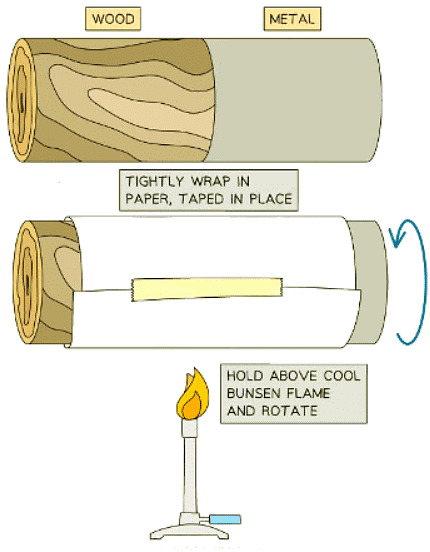Class 10 Exam > Class 10 Notes > Physics for GCSE/IGCSE > Demonstrating Conduction
Demonstrating Conduction | Physics for GCSE/IGCSE - Class 10 PDF Download
Experiments Demonstrating Thermal Conductors
- Good thermal conductors are materials that easily transfer heat. For instance, a metal pan or a ceramic tea cup demonstrates this property effectively.
- Conversely, bad thermal conductors, also known as insulators, are materials that do not transfer heat well. An example of this is a woolen blanket or layers of cardboard or paper.
Comparing Conduction in Tiles and Textiles
This experiment illustrates the purpose of using rugs and carpets in homes:
- Locate a section of floor covered in tiles or made of stone.
- Within the same room, place a rug or a thick bath towel on another section of the floor.
- It's essential that the textile remains in position for several hours to allow both surfaces to reach thermal equilibrium, meaning they reach the same temperature.

- Stand barefooted and conduct the following steps:
- Position one foot on the tiled or stone area and the other on the textile (rug or towel).
- Pay attention to the perceived temperature of the two surfaces as sensed through your feet or hands.
- Despite both surfaces being at precisely the same temperature, the tiles may feel cold, while the textile (rug or towel) may feel warm.

Explanation
- Tiles and stone possess high thermal conductivity, facilitating the rapid transfer of heat.
- When the foot touches these surfaces, heat dissipates from the foot, creating a sensation of coldness.
- Consequently, the foot experiences a decrease in temperature due to heat loss to the tiles.
- Conversely, textiles like rugs act as effective insulators, exhibiting poor thermal conductivity.
- When the foot contacts the rug, minimal heat is transferred away from it.
- As a result, the foot perceives warmth compared to the one losing heat to the tiles.
- Essentially, the foot maintains its initial temperature when in contact with the rug.
Comparing Conduction in Wood and Paper
- A cylindrical rod is composed of equal parts wood and metal, with paper tightly wrapped around it.

- Apply a gentle flame to the paper covering the junction between the wood and metal parts of the cylindrical rod, ensuring the rod is held above the flame.
- Rotate the rod to evenly heat the paper along its entire circumference.
- Cease heating once the paper shows clear discoloration.
- Take the rod out of the flame and carefully unwrap the paper to examine the burn pattern.
- Notice a clear pattern emerges: the paper remains undamaged where it contacted the metal surface, while charring occurs where it touched the wood surface.

Explanation
- Metal exhibits high heat conductivity.
- Heat conducted away from the paper into the metal and dispersed along its length prevented the paper from heating significantly where it contacted the metal.
- Wood, on the other hand, acts as a good insulator due to its poor heat conductivity.
- Lack of heat transfer from the paper into the wood caused the paper to heat sufficiently to initiate burning where it contacted the wood.
Demonstrating Different Rates of Thermal Conduction in Metals
- A straightforward experiment can showcase the varying conductivity of different materials. This experiment can be conducted using equipment similar to the one depicted below.

- Attach ball bearings to each strip, equidistant from the center, using a small amount of wax.
- Subsequently, invert the strips and gently heat the center using a candle, ensuring each strip heats where they intersect.
- As heat conducts towards the ball bearing, the wax will melt, causing the ball bearing to drop.
- By recording the time taken for this occurrence on each strip, their relative thermal conductivities can be ascertained.
The document Demonstrating Conduction | Physics for GCSE/IGCSE - Class 10 is a part of the Class 10 Course Physics for GCSE/IGCSE.
All you need of Class 10 at this link: Class 10
|
129 videos|188 docs|35 tests
|
FAQs on Demonstrating Conduction - Physics for GCSE/IGCSE - Class 10
| 1. What is thermal equilibrium and why is it important in thermal physics? |  |
Ans. Thermal equilibrium is the state in which two objects are at the same temperature and no heat flows between them. It is important in thermal physics because it allows us to study heat transfer and understand how temperature affects objects.
| 2. How does thermal conduction occur and what factors affect it? |  |
Ans. Thermal conduction is the process of heat transfer through a material without the material itself moving. Factors that affect thermal conduction include the material's conductivity, thickness, and surface area.
| 3. Can you provide examples of demonstrations for thermal conduction? |  |
Ans. Examples of demonstrations for thermal conduction include using metal rods of different lengths to show how heat travels, or using a candle and different materials to see which conducts heat best.
| 4. What is the purpose of the thermal conduction experiment summary? |  |
Ans. The purpose of the thermal conduction experiment summary is to consolidate the findings of the experiment, analyze the data collected, and draw conclusions about heat transfer through different materials.
| 5. How can understanding heat transfer through conduction help in real-life applications? |  |
Ans. Understanding heat transfer through conduction can help in designing better insulation for buildings, improving the efficiency of electronic devices, and optimizing heating and cooling systems.
Related Searches




















